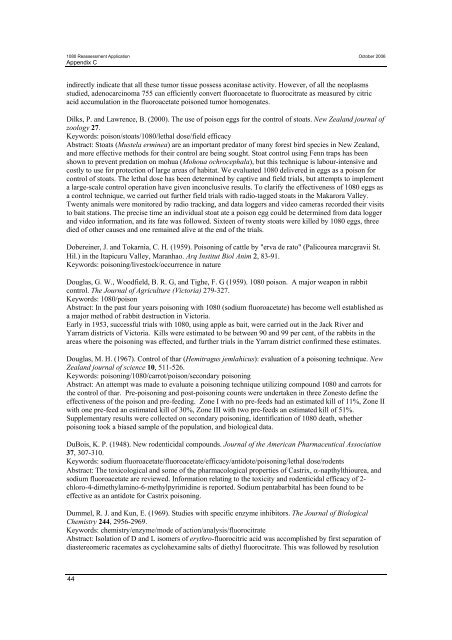Source: Landcare Research (1964). Control of poisons. Royal ...
Source: Landcare Research (1964). Control of poisons. Royal ...
Source: Landcare Research (1964). Control of poisons. Royal ...
Create successful ePaper yourself
Turn your PDF publications into a flip-book with our unique Google optimized e-Paper software.
1080 Reassessment Application October 2006<br />
Appendix C<br />
indirectly indicate that all these tumor tissue possess aconitase activity. However, <strong>of</strong> all the neoplasms<br />
studied, adenocarcinoma 755 can efficiently convert fluoroacetate to fluorocitrate as measured by citric<br />
acid accumulation in the fluoroacetate poisoned tumor homogenates.<br />
Dilks, P. and Lawrence, B. (2000). The use <strong>of</strong> poison eggs for the control <strong>of</strong> stoats. New Zealand journal <strong>of</strong><br />
zoology 27.<br />
Keywords: poison/stoats/1080/lethal dose/field efficacy<br />
Abstract: Stoats (Mustela erminea) are an important predator <strong>of</strong> many forest bird species in New Zealand,<br />
and more effective methods for their control are being sought. Stoat control using Fenn traps has been<br />
shown to prevent predation on mohua (Mohoua ochrocephala), but this technique is labour-intensive and<br />
costly to use for protection <strong>of</strong> large areas <strong>of</strong> habitat. We evaluated 1080 delivered in eggs as a poison for<br />
control <strong>of</strong> stoats. The lethal dose has been determined by captive and field trials, but attempts to implement<br />
a large-scale control operation have given inconclusive results. To clarify the effectiveness <strong>of</strong> 1080 eggs as<br />
a control technique, we carried out further field trials with radio-tagged stoats in the Makarora Valley.<br />
Twenty animals were monitored by radio tracking, and data loggers and video cameras recorded their visits<br />
to bait stations. The precise time an individual stoat ate a poison egg could be determined from data logger<br />
and video information, and its fate was followed. Sixteen <strong>of</strong> twenty stoats were killed by 1080 eggs, three<br />
died <strong>of</strong> other causes and one remained alive at the end <strong>of</strong> the trials.<br />
Dobereiner, J. and Tokarnia, C. H. (1959). Poisoning <strong>of</strong> cattle by "erva de rato" (Palicourea marcgravii St.<br />
Hil.) in the Itapicuru Valley, Maranhao. Arq Institut Biol Anim 2, 83-91.<br />
Keywords: poisoning/livestock/occurrence in nature<br />
Douglas, G. W., Woodfield, B. R. G, and Tighe, F. G (1959). 1080 poison. A major weapon in rabbit<br />
control. The Journal <strong>of</strong> Agriculture (Victoria) 279-327.<br />
Keywords: 1080/poison<br />
Abstract: In the past four years poisoning with 1080 (sodium fluoroacetate) has become well established as<br />
a major method <strong>of</strong> rabbit destruction in Victoria.<br />
Early in 1953, successful trials with 1080, using apple as bait, were carried out in the Jack River and<br />
Yarram districts <strong>of</strong> Victoria. Kills were estimated to be between 90 and 99 per cent, <strong>of</strong> the rabbits in the<br />
areas where the poisoning was effected, and further trials in the Yarram district confirmed these estimates.<br />
Douglas, M. H. (1967). <strong>Control</strong> <strong>of</strong> thar (Hemitragus jemlahicus): evaluation <strong>of</strong> a poisoning technique. New<br />
Zealand journal <strong>of</strong> science 10, 511-526.<br />
Keywords: poisoning/1080/carrot/poison/secondary poisoning<br />
Abstract: An attempt was made to evaluate a poisoning technique utilizing compound 1080 and carrots for<br />
the control <strong>of</strong> thar. Pre-poisoning and post-poisoning counts were undertaken in three Zonesto define the<br />
effectiveness <strong>of</strong> the poison and pre-feeding. Zone I with no pre-feeds had an estimated kill <strong>of</strong> 11%, Zone II<br />
with one pre-feed an estimated kill <strong>of</strong> 30%, Zone III with two pre-feeds an estimated kill <strong>of</strong> 51%.<br />
Supplementary results were collected on secondary poisoning, identification <strong>of</strong> 1080 death, whether<br />
poisoning took a biased sample <strong>of</strong> the population, and biological data.<br />
DuBois, K. P. (1948). New rodenticidal compounds. Journal <strong>of</strong> the American Pharmaceutical Association<br />
37, 307-310.<br />
Keywords: sodium fluoroacetate/fluoroacetate/efficacy/antidote/poisoning/lethal dose/rodents<br />
Abstract: The toxicological and some <strong>of</strong> the pharmacological properties <strong>of</strong> Castrix, α-napthylthiourea, and<br />
sodium fluoroacetate are reviewed. Information relating to the toxicity and rodenticidal efficacy <strong>of</strong> 2chloro-4-dimethylamino-6-methylpyrimidine<br />
is reported. Sodium pentabarbital has been found to be<br />
effective as an antidote for Castrix poisoning.<br />
Dummel, R. J. and Kun, E. (1969). Studies with specific enzyme inhibitors. The Journal <strong>of</strong> Biological<br />
Chemistry 244, 2956-2969.<br />
Keywords: chemistry/enzyme/mode <strong>of</strong> action/analysis/fluorocitrate<br />
Abstract: Isolation <strong>of</strong> D and L isomers <strong>of</strong> erythro-fluorocitric acid was accomplished by first separation <strong>of</strong><br />
diastereomeric racemates as cyclohexamine salts <strong>of</strong> diethyl fluorocitrate. This was followed by resolution<br />
44








![Application for test certificate [pdf, 131kb]](https://img.yumpu.com/50666502/1/184x260/application-for-test-certificate-pdf-131kb.jpg?quality=85)








